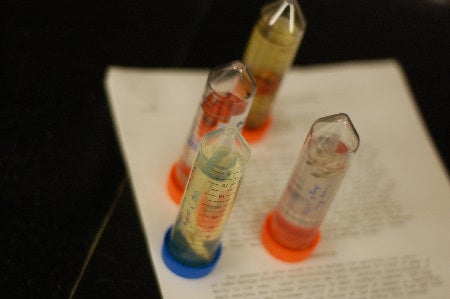
The DFWI maintains several laboratories devoted to analytical chemistry within the Bolton Laboratory complex. Samples collected for numerous research projects are brought into this lab for analysis of chemical and physical parameters (e.g. pH, conductivity, dissolved oxygen, chlorophyll, and nutrients). Researchers working on a host of research projects in both the Lake George and Adirondack regions are supported by this laboratory. Current research efforts employing this lab include the Adirondack Effects Assessment Program (acid rain studies), Lake George Limnological Assessment Program, and the Asian Clam Eradication Task Force.
Ion Chromatography
Our ion chromatograph is currently configured for analysis of anions such as nitrate, nitrite, sulfate and chloride in dilute aqueous solutions. This instrument supports research projects aimed at a better understanding of atmospheric acid deposition, limnology, hydrology and eutrophication processes. This instrument is also capable of analysis for dilute organic acids such as acetate or formate, components of naturally acid brown water lake systems.
Flurometer
The flurometer is configured to determine the concentration of chlorophyll in sample concentrates and aqueous solutions. Chlorophyll concentrations serve as a surrogate for the density of algal cells in lake water systems. The instrument is also capable of analysis for rhodamine or fluromine dyes used in tracer studies to characterize water movement patterns in lakes and groundwaters.
pH Meter
pH analysis provide a measure of the acidity or alkalinity of water samples. Low pH values in the range of 4 to 5 are characteristic of acid deposition while high pH values in excess of 8 are indicative of alkaline or at times eutrophic (nutrient enriched) systems. pH analysis provides a means to characterize the diversity of waters.
Spectrophotometers
Spectrophotometric or colorimetric analysis forms the basis for numerous laboratory assays, including those for phosphorus, nitrogen (ammonia and total), and soluble silica. Phosphorus, the nutrient generally considered the ‘limiting’ nutrient controlling algal growth in lakes is fractionated and analyzed colorimetrically to the part per billion level in the DFWI laboratory. Nitrogen, acting as both an essential nutrient and an acidic component of rainfall, can be analyzed colorimetrically as both total nitrogen and its component parts (nitrate, nitrite and ammonia).
Gravimetric analyzers
Gravimetric analysis is based on the ability to accurately weigh miniscule amounts of material. The DFWI lab scales (balances) are calibrated to the microgram, (one millionth of a gram), level. Gravimetric analysis looks for suspended solids and organisms in lake and stream samples, while also providing the ability to prepare exceptionally accurate standard solutions to calibrate other instruments.
Conductivity Meter
Specific conductance or conductivity is measured on most water samples entering the laboratory, both as a means of characterizing waters but also as a component of quality control. Specific conductance is a measure of the ability of water to carry an electrical current, and is used to estimate the number of ions (charged particles). It is somewhat related to both the hardness and alkalinity (acid-buffering capacity) of the water and may influence the degree to which nutrients remain in the water. The sum of all ions recorded for a lake water sample may be converted to an estimated conductivity which when compared to the measured conductivity proves a means of quality control for the laboratory measurements.
Please contact us for our latest water testing prices.
